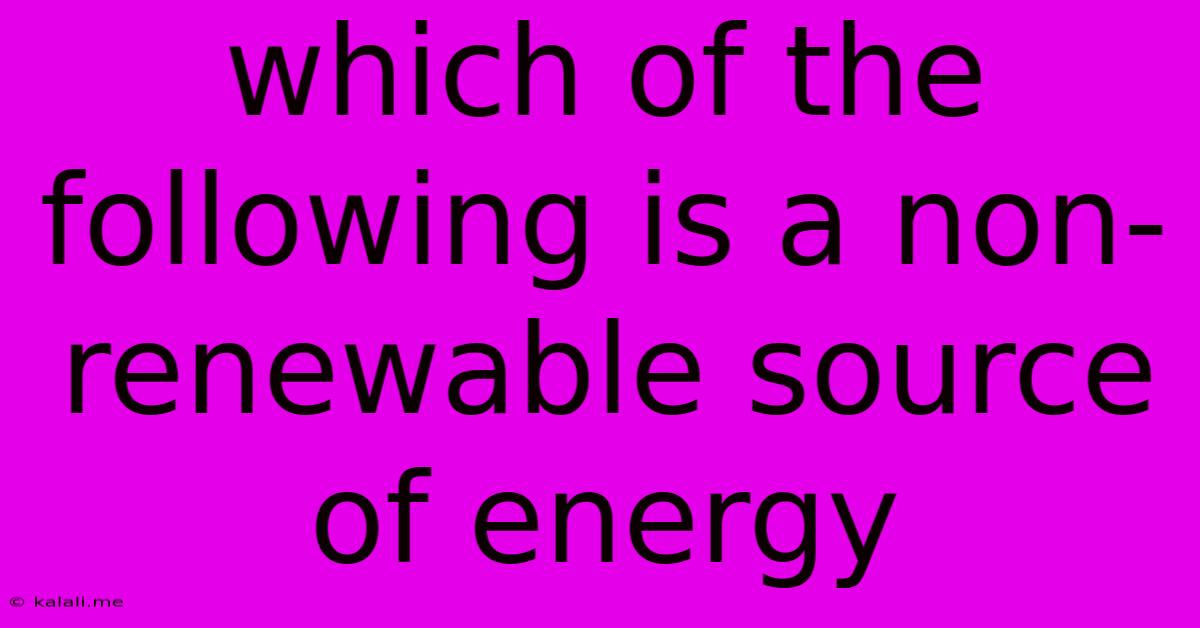Which Of The Following Is A Non-renewable Source Of Energy
Kalali
Jun 12, 2025 · 3 min read

Table of Contents
Which of the Following is a Non-Renewable Source of Energy? Understanding Energy Resources
This article will explore the concept of renewable and non-renewable energy sources, providing clear definitions and examples. We'll delve into why some energy sources are considered finite and the implications for our planet's future. Understanding the difference between these energy types is crucial for making informed decisions about energy consumption and sustainability.
What are Renewable and Non-Renewable Energy Sources?
The key difference lies in their ability to replenish themselves. Renewable energy sources are naturally replenished over a relatively short period. They are sustainable and have minimal environmental impact compared to their counterparts. Non-renewable energy sources, on the other hand, are finite resources that take millions of years to form. Once depleted, they are essentially gone. Their extraction and use often have significant environmental consequences.
Examples of Non-Renewable Energy Sources:
Several energy sources fall under the non-renewable category. The most common ones include:
-
Fossil Fuels: This is the largest category of non-renewable energy sources. It encompasses:
- Coal: Formed from ancient plant matter compressed over millions of years. Burning coal releases large amounts of greenhouse gases, contributing significantly to climate change. Coal mining also causes extensive environmental damage.
- Oil (Petroleum): A thick, black liquid formed from the remains of ancient marine organisms. Used for transportation, heating, and manufacturing plastics, oil extraction and refining have substantial environmental consequences, including oil spills and air pollution.
- Natural Gas: A naturally occurring hydrocarbon gas, often found alongside oil. While considered a cleaner-burning fossil fuel compared to coal and oil, it still releases greenhouse gases. The extraction process, particularly fracking, has raised environmental concerns.
-
Nuclear Energy: While not a fossil fuel, nuclear energy relies on uranium, a finite resource. Nuclear power plants generate electricity through nuclear fission, a process that releases energy but also produces radioactive waste that requires safe, long-term storage.
Examples of Renewable Energy Sources (for contrast):
Understanding non-renewable energy is best done by contrasting it with its opposite. Renewable energy sources include:
- Solar Energy: Harnessing the power of the sun using photovoltaic cells or concentrated solar power systems. It's a clean and sustainable energy source, although the manufacturing of solar panels does have an environmental footprint.
- Wind Energy: Utilizing wind turbines to convert wind energy into electricity. Wind power is a clean and sustainable source, but its impact on wildlife and the landscape needs careful consideration.
- Hydropower: Generating electricity from the flow of water, typically using dams. While a relatively clean source, hydropower projects can affect river ecosystems and displace communities.
- Geothermal Energy: Utilizing heat from the Earth's interior to generate electricity or provide heating. It's a clean and sustainable energy source, but its geographic limitations restrict its widespread use.
- Biomass Energy: Burning organic matter, such as wood or agricultural waste, to produce energy. While renewable if managed sustainably, it can contribute to air pollution if not properly controlled.
Conclusion: The Importance of Transitioning to Renewable Energy
The depletion of non-renewable energy sources and their detrimental environmental impacts necessitates a global shift towards renewable energy. Investing in renewable energy technologies and implementing sustainable energy policies are crucial for ensuring a secure and environmentally responsible energy future for generations to come. Choosing renewable sources helps mitigate climate change, reduce air and water pollution, and promote energy independence. Understanding the distinction between renewable and non-renewable energy is the first step towards making informed choices that benefit both our planet and our future.
Latest Posts
Latest Posts
-
Elements In Groups 3 12 Are Called
Jun 13, 2025
-
How Much Is 200c In F
Jun 13, 2025
-
Specific Weight Of Water In Kn M3
Jun 13, 2025
-
Land Surrounded By Water On Three Sides
Jun 13, 2025
-
What Are The Factors For 95
Jun 13, 2025
Related Post
Thank you for visiting our website which covers about Which Of The Following Is A Non-renewable Source Of Energy . We hope the information provided has been useful to you. Feel free to contact us if you have any questions or need further assistance. See you next time and don't miss to bookmark.